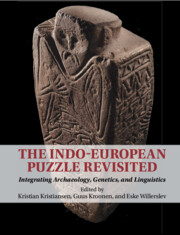Book contents
- The Indo-European Puzzle Revisited
- The Indo-European Puzzle Revisited
- Copyright page
- Contents
- Figures
- Tables
- Contributors
- Preface
- Introduction
- Part I Early Indo-European and the Origin of Pastoralism
- Part II Migratory Processes and Linguistic Dispersals between Yamnaya and the Corded Ware
- Part III The Cultural and Linguistic Significance of Bell Beakers along the Atlantic Fringe
- Part IV The Bronze Age Chariot and Wool Horizons
- 14 Relative and Absolute Chronologies of the Chariot Complex in Northern Eurasia and Early Indo-European Migrations
- 15 Indo-European and Indo-Iranian Wagon Terminology and the Date of the Indo-Iranian Split
- 16 Fire and Water: The Bronze Age of the Southern Urals and the Rigveda
- 17 Wool Fibers of the Northern Eurasian Bronze Age: The Cultural and Geographical Contexts
- 18 An Archaeolinguistic Approach to Indo-European Wool Terminology
- Part V Kinship Systems, Marriage, Fosterage, Free, and Unfree
- Concluding Reflections
- Index
- References
14 - Relative and Absolute Chronologies of the Chariot Complex in Northern Eurasia and Early Indo-European Migrations
from Part IV - The Bronze Age Chariot and Wool Horizons
Published online by Cambridge University Press: 29 April 2023
- The Indo-European Puzzle Revisited
- The Indo-European Puzzle Revisited
- Copyright page
- Contents
- Figures
- Tables
- Contributors
- Preface
- Introduction
- Part I Early Indo-European and the Origin of Pastoralism
- Part II Migratory Processes and Linguistic Dispersals between Yamnaya and the Corded Ware
- Part III The Cultural and Linguistic Significance of Bell Beakers along the Atlantic Fringe
- Part IV The Bronze Age Chariot and Wool Horizons
- 14 Relative and Absolute Chronologies of the Chariot Complex in Northern Eurasia and Early Indo-European Migrations
- 15 Indo-European and Indo-Iranian Wagon Terminology and the Date of the Indo-Iranian Split
- 16 Fire and Water: The Bronze Age of the Southern Urals and the Rigveda
- 17 Wool Fibers of the Northern Eurasian Bronze Age: The Cultural and Geographical Contexts
- 18 An Archaeolinguistic Approach to Indo-European Wool Terminology
- Part V Kinship Systems, Marriage, Fosterage, Free, and Unfree
- Concluding Reflections
- Index
- References
Summary
Linking the distribution of wheeled transport to the evolution of language is a strategy often employed to locate the Indo-European (IE) motherland and trace the formation of various Indo-European languages in different parts of the Old World. The underlying assumption is that archaeological assemblages that are separate in space but similar in appearance represent people speaking dialects of the same language. The chronology, sources, and spatiality of the IE migrations, however, remain topics of heated discussion. Specifically, researchers disagree on which early archaeological phenomenon represents the source of early IE migration (Grigoriyev 2002; Anthony 2007; Allentoft et al. 2015; Klejn et al. 2017).
- Type
- Chapter
- Information
- The Indo-European Puzzle RevisitedIntegrating Archaeology, Genetics, and Linguistics, pp. 247 - 256Publisher: Cambridge University PressPrint publication year: 2023



